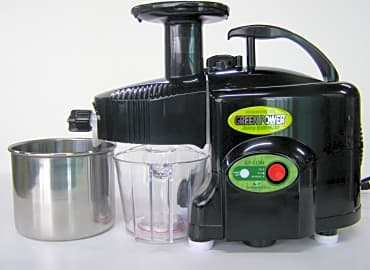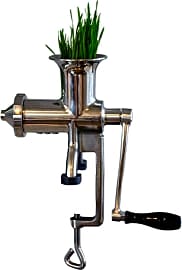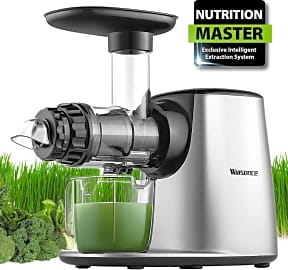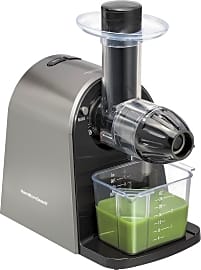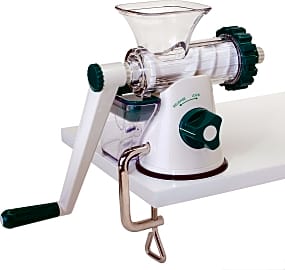The 10 Best Wheatgrass Juicers

This wiki has been updated 38 times since it was first published in July of 2015. Eating right can be extremely time-consuming, especially if you have to prepare meals for a whole family. These wheatgrass juicers, however, allow you to get a ton of vitamins and nutrients in each glass without inundating you with prep work, making them perfect for health-conscious people who are constantly on the go. We've ranked them here by efficiency, durability, and ease of use and cleanup. When users buy our independently chosen editorial choices, we may earn commissions to help fund the Wiki.
Editor's Notes
February 03, 2020:
Going over the selections on our previous list, there were one or two options whose build quality weren't quite up to snuff, and whose designs matched identically to a number of other companies' offerings, leading us to believe they were from faceless factories in low-wage countries that promise little more than the bare minimum of quality. In their places, we included the Samson Super SB0850 and the Super Angel Premium Deluxe, both of which are rugged and capable enough to fit in at a professional juice bar, but easy enough to use that anyone could enjoy their quality at home.
We tend to prefer steel components wherever possible in a category like this, as you'd also see in our masticating and centrifugal juicer lists, even as BPA-free components have become cheaper and more readily available. Augers in particular, seem to have a much easier time pushing through wheatgrass and other veggies, and to last longer while doing it, when they're made of steel.
How To Choose The Right Wheatgrass Juicer
Manual models will be cheaper, but considerably more labor intensive.
When buying a wheatgrass juicer, you first decision will have to be whether you want an electric or manual model. Manual models will be cheaper, but considerably more labor intensive. Considering that you are probably juicing wheatgrass in an attempt to be more healthy, then you may very well prefer the arm workout manual juicing provides, though, more often than not, most people who choose a manual model don't stick with juicing. If you still decide you want a manual juicer, your next decision will be whether to buy a metal or plastic model. Plastic manual juicers are the cheapest option, but are more prone to breaking. Metal manual juicers are the most durable option and will often outlast both plastic manual models and electric models by many years. There is a good chance that if you buy an all-stainless-steel manual juicer, it will last your entire lifetime.
For those who prefer convenience and don't suffer from such tight budgetary restraints, an electric model is the best bet. When choosing your electric juicer, ask yourself if you plan on juicing a variety of fruits and vegetables or solely wheatgrass. If you will regularly juice other food items as well as wheatgrass, your best bet may be to choose an all-purpose masticating juicer. On the other hand, if you know that you will only be juicing wheatgrass, you may be able to save a little money by purchasing a dedicated electric wheatgrass juicer.
You should never try to juice wheatgrass in a blender or centrifugal juicer. The fibrous nature of wheatgrass can quickly dull the blades of a blender, which are notoriously difficult to sharpen. Centrifugal juicers spin at extremely high speeds, which creates a lot of heat. Heat breaks down some of the vitamins and enzymes in juice, making it less nutritious. Masticating juicers do not have any blades. They utilize an auger or grinding gears to mash foods and extract their juice. They also often run at a low rpm to ensure they will perform consistently for years and provide you with the most nutritious juice possible.
Wheatgrass Juicing Tips
One of the first things you may notice when you start juicing wheatgrass is that, unfortunately, it actually tastes just like grass. Unless you are a sheep or cow, this probably won't be the most pleasant thing you have ever tasted. Many people just choose to stop drinking wheatgrass at this point, assuming that it always has to taste this bad, but luckily this isn't true. You can easily improve the taste of your wheatgrass drink by incorporating a few sweet fruits or vegetables. Apples, carrots, grapes, and pineapple are good options that mask the flavor of wheatgrass well.
Stray blades of grass may sometimes pass through a juicer without being fully masticated.
Adding additional ingredients can actually help you maximize the juice extracted from your wheatgrass, too. Stray blades of grass may sometimes pass through a juicer without being fully masticated. You can avoid this in two ways. If mixing the wheatgrass with fruits or vegetables, you can mash the wheatgrass in between slices of the other food items. This helps to ensure the grass is fully pulverized along with the other ingredients. If you just plan on making a shot or two of wheatgrass juice and aren't going to be mixing it with other ingredients, twist the blades of wheatgrass into thick clumps before passing them into the machine. A juicer has a better chance of fully masticating a thick clumpy knot of wheatgrass and thereby extracting the maximum amount of juice than it does with stray blades.
Before juicing your wheatgrass, you should also check it to make sure that it is free from any mold and remove yellow sprouts. The yellow sprouts can sometimes taste a little rotten as they are in the process of dying. You should always juice your wheatgrass just before consuming it. While it can be stored in the refrigerator, it will begin to oxidize quickly, resulting in deterioration of the beneficial nutrients. If you must juice your wheatgrass in advance, try not to do so more than one hour before you plan to consume it. When you first start out making wheatgrass juices and smoothies, don't add too much. This will help ensure that your drinks don't taste too much like lawn clippings. Start by introducing a little bit to your beverage and, over time, as you get used to the taste, you can add more.
Benefits Of Wheatgrass
The benefits wheatgrass offers the human body are boundless. Triticum aestivium, as it is known in the scientific community, is packed with a powerful combination of nutrients, phytonutrients, and enzymes in levels not found in many other foods. It contains more vitamin C than oranges, more vitamin A than carrots, and a broad spectrum of B vitamins. It also contains beneficial minerals, like magnesium, sodium, potassium, and calcium, and amino acids.
It contains more vitamin C than oranges, more vitamin A than carrots, and a broad spectrum of B vitamins.
The enzymes in wheatgrass aid in digestion, helping your body to better breakdown the food you eat and absorb nutrients more efficiently. In addition to aiding in digestion, wheatgratt also helps the body rid itself of toxins, free radicals, and other impurities. This is because it contains a large amount of antioxidants. The detoxifying effects of wheatgrass have been found to ease the symptoms or irritable bowel syndrome and relieve constipation, resulting in less bloating, gas, and abdominal discomfort.
The high level of chlorophyll wheatgrass contains is another key factor in the health benefits it provides. Chlorophyll molecules are actually very similar to hemoglobin molecules. This similarity is one of the reasons wheatgrass nutrients are so quickly absorbed by the human body. It is also why wheatgrass can help to oxygenate the blood and normalize blood pressure. The high level of beneficial vitamins, nutrients, minerals, and enzymes wheatgrass contains in conjunction with how quickly and easily the body can absorb them can enhance the function of the immune system, making the body more capable of fighting off infections and diseases.





